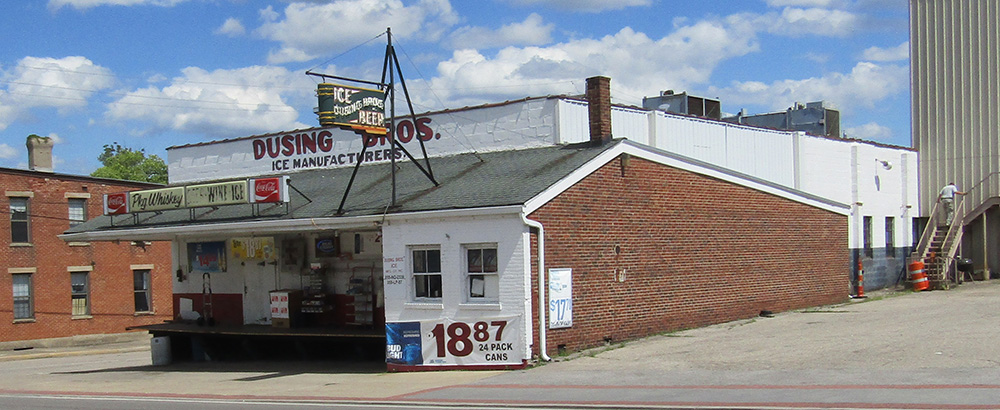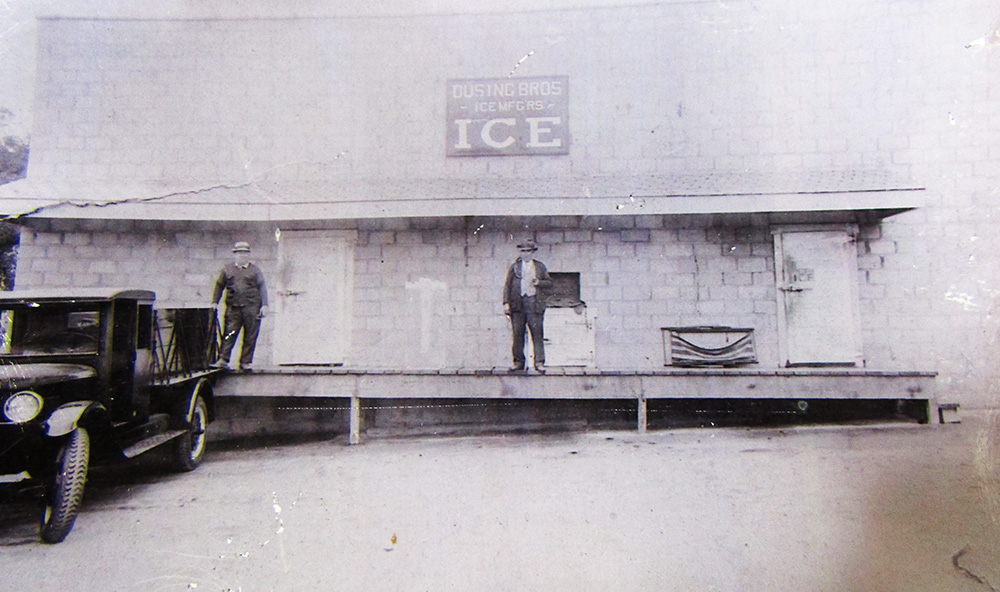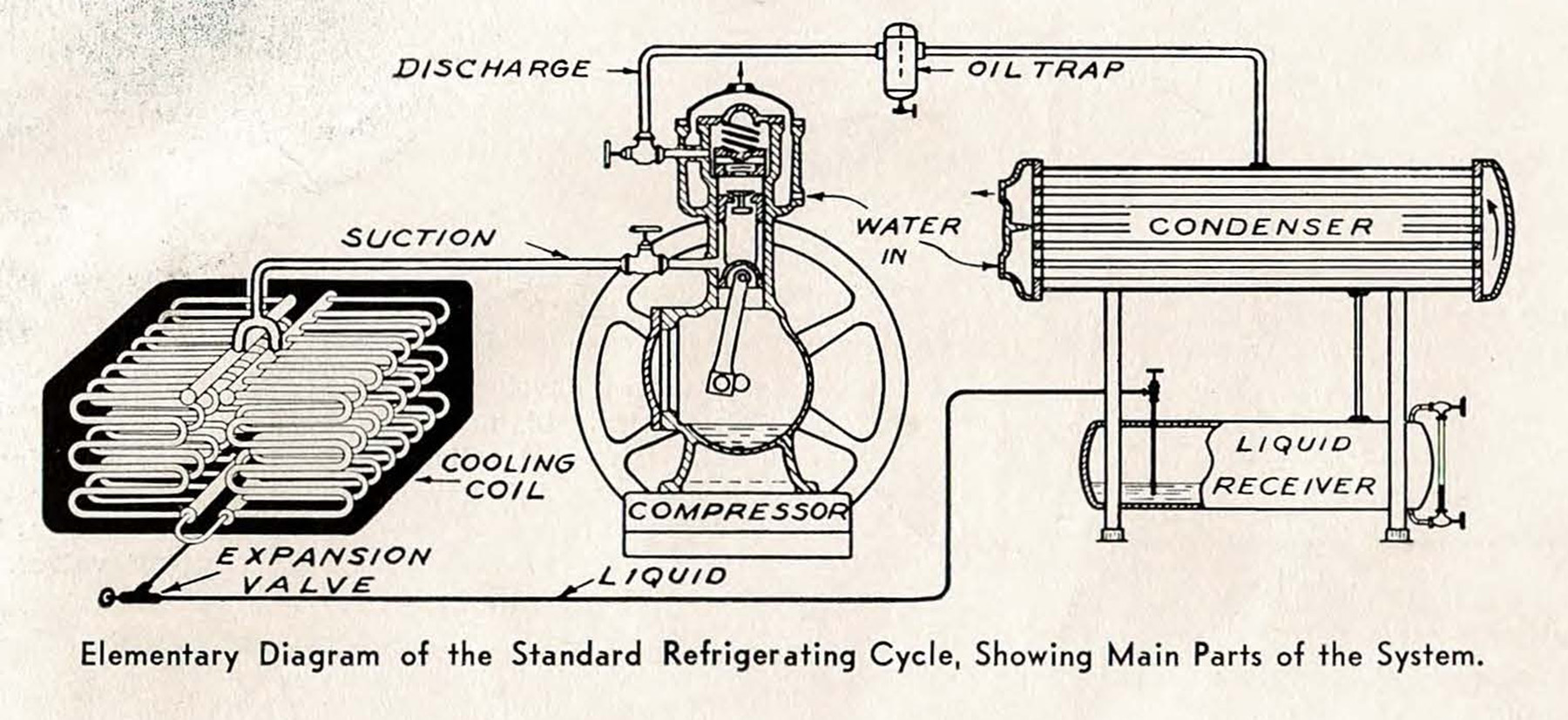
Dusing Brothers Ice, Elsmere, Kentucky (Photo by Paul A. Tenkotte)
By Paul A. Tenkotte
Special to NKyTribune
I spent a bittersweet June 30 afternoon this year returning some books on ice manufacturing to the Dusing brothers on Dixie Highway in Erlanger. It was the last day of operation for Dusing Brothers Ice, in business for 89 years.
The Dusings have warm, inviting personalities, completely opposite of their “icy” pasts. Tom, Bern, and Ron Dusing are the grandsons of Ben Dusing, who with his brother Frank, established the business in 1928 and constructed the original building (still standing). Ben Dusing had been a dairy farmer on Highland Avenue in present-day Fort Wright. He and Frank established the ice business for their sons.
Ben had three sons, Bud, Sylvester and Bernard, who all became involved in the business. Frank had two sons in the enterprise, Ed and Frank.
Sylvester (a World War II veteran) and Anne Marie Herrmann Dusing, in turn, had five children—Jim, Tom, Bern, Ron, and Anita. In November 1971, Sylvester died, and three of his sons—Tom, Bern, and Ron—assumed his share of the business. Eventually, they purchased the remaining family shares.

Bern (left) and Ron Dusing (Photo by Paul A. Tenkotte)
Tom retired from the business several years ago, and now Bern and Ron will themselves “chill out” in retirement. They deserve a rest. As they described it, the work could be absolutely grueling. “It’s work,” Ron declared matter-of-factly. “And work that could lead to some big bodily pains,” Bern added.
In addition to the ice manufacturing business, the Dusings operated a “pony keg,” drive-up service. Customers could park along the loading dock, and the Dusings, or one of their employees, would come out and ask the customers what they wanted. In addition to ice and snacks, the Dusing family sold beer and liquor following the end of Prohibition in 1933.
When I was in high school in the late 1970s, a couple of my very good friends—Greg Bedel and Jerry Eilerman—worked at Dusing Brothers Ice. They gave me a tour of the ice making facilities years ago, and Bern reacquainted me with the old system last week.
About seven years ago, the old ammonia compressor system of making ice at the plant broke down, and the brothers abandoned the making of ice in the traditional 300-pound blocks. For decades, the manufacture of mass-produced ice had used this system, which can best be explained by reviewing a little basic science.

Gauges from the old York ammonia compressor (Photo by Paul A. Tenkotte)
Water, a compound of hydrogen and oxygen, occurs naturally in three different states—liquid, gas, and solid (ice). Vaporization is the process whereby a liquid (such as water) changes into a gas. The opposite, condensation, describes the process whereby a gas changes to a liquid, such as condensation on an icy beverage glass on a hot summer day, or the fog on the inside of a window on a cold winter day.
Now, what about perspiration on a hot summer day? Our bodies’ sweat glands produce sweat, principally composed of water. And here’s the twist. Our bodies generate both “sensible heat” and “latent heat.” If someone takes your temperature with a thermometer, they can measure your sensible heat, probably somewhere around the average of 98.6 degrees Fahrenheit, although it differs from person-to-person, and even hour-to-hour.
The term “latent heat” literally derives from the Latin word for “hidden.” As hidden heat, latent heat would be the energy (heat) used by your body when it vaporizes your sweat into a gas. Scientists know that no temperature change occurs during this change of state, and you realize that you can’t see this heat with your naked eye. However, you know that it is definitely occurring. Without sweating and then vaporization of your sweat into a gas, your body temperature would rise to dangerous levels. So, in simple terms, the heat is transferred from a liquid to a gas state, keeping you standing up upright.
And now back to the manufacture of ice. In the late-nineteenth century, the manufacture of ice through the use of an ammonia compressor became commercially successful. Ammonia, a compound of nitrogen and hydrogen, can occur in both liquid and gas forms. Because its boiling point is so low (-27.94 degrees Fahrenheit) and its freezing point (-107.86 degrees Fahrenheit) so much lower than that of water (32 degrees Fahrenheit), ammonia is a good refrigerant.

Ben (left) and Frank Dusing, circa the 1930s (Photo courtesy of Dusing Brothers Ice)
The refrigeration process formerly used in making 300-pound blocks of ice at Dusing Brothers utilized an ammonia compressor. Manufactured by York, these compressors were vital to the refrigeration cycle (see illustration). Let’s start with the “liquid receiver,” from which liquid ammonia was pumped to “cooling coils” that were placed in a brine solution in a tank. Galvanized cans of water were then placed in rows in the brine tank. The brine absorbed some of the heat from the water cans, and in turn, the liquid ammonia in the coils absorbed heat from the brine.
Since ammonia has such a low boiling rate (about 240 degrees Fahrenheit lower than water!), it can absorb a lot of heat before it becomes vaporized into a gas. As soon as the ammonia liquid forms into ammonia gas, it is suctioned off by the compressor. The compressor then “compresses” the ammonia gas, so that it can be sent to a condenser. The condenser then literally “condenses” the gas back into ammonia liquid for recirculation.

Aerial view of Dusing Brothers Ice, circa 1988. To the right can be seen the old Village Cinema movie theater. (Photo provided)
Dusing Brothers had two large tanks into which the galvanized cans of water were placed. Above the brine and cans were removable floor planks. The Dusings estimate that the two tanks could produce about 57 tons of ice per day.
Years ago, before the popularity of electric refrigerators, Dusing Brothers delivered ice to homes and businesses. Home customers would then place ice blocks in their “iceboxes” to keep foods cold. The Dusings believe that the last home ice delivery occurred about 1957 or so.
In addition to ice delivery to homes and businesses, Dusing Brothers loaded long-distance trucks traveling the Dixie Highway. These trucks carried fruit, vegetables, and meats from places as far away as Mexico and the Southeastern United States to markets as far north as Canada, Detroit, and Buffalo. The ice, and of course melted water, kept the produce cold from its place of origin until the trucks could be reloaded with ice at Dusing Brothers for the final legs of their journeys.
As time passed, the Dusings added modern plate ice machines in circa 1979, 1984, and 1988. In the mid-to-late 1960s, they installed “merchandisers,” that is, ice machines at gas stations and stores. The brothers also expanded their facility, constructing a turbo room in 1988, and adding a large warehouse in 1998. In April 2017, they sold the ice portion of their business to Home City Ice.
Bern and Ron both started work at the family business in the 1960s, when they were high school students. Obviously, as Ron described, retiring is a “tug at the heartstrings.” They have always regarded their customers as family, and their customers have felt the same affinity towards them. And as Ron stated, tongue-in-cheek, “I look forward to spending time with my grandkids and family, and after working such long hours, to reintroducing myself to my wife.”
We want to learn more about the history of your business, church, school, or organization in our region (Cincinnati and Northern Kentucky). If you would like to share your rich history with others, please contact the editor of “Our Rich History,” Paul A. Tenkotte, at tenkottep@nku.edu. Paul A. Tenkotte, PhD is Professor of History and Director of the Center for Public History at NKU.

























